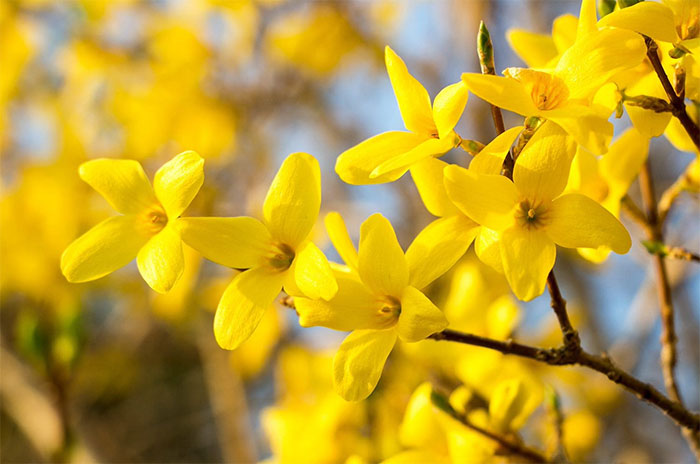Forsythia Flower Symbolism Facts & Meaning: Zodiac, Superstitions, Dreams, and Legends
I
Forsythia Flower Facts
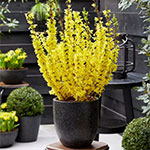
The four-petaled Forsythia, also known as golden bell, is a tiny and elegant deciduous shrub that blooms on old wood in the spring. This golden yellow blossom is mostly native to eastern Asia, mainly in China, housing about 10 species, and to Eastern Europe with only one native species. Typically, Forsythias are found in the Chinese provinces of Shanxi, Henan, Shaanxi, and Gansu.
Since Forsythia completely blooms in late March to mid-April, spring is a particularly beautiful time to see it. When they have fully blossomed, they yield tan to brown fruits known as Lian Qiao, which are dry capsules. They thrive on open, well-draining soils and direct sunlight, therefore spring is the best time to plant them as they lose their ornamental charm in other seasons.
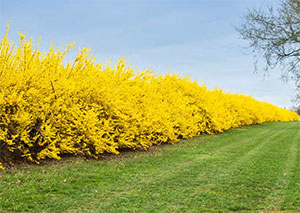
II
Forsythia Flower Uses
In traditional Chinese medicine, the fruit of the Forsythia plant known as Lian Qiao is used to cleanse the body and treat common illnesses like fever, headache, dehydration or excessive thirst, and swelling of the tiny airways. Forsythia is said to be cold and bitter. Before using Forsythia, it is strongly advised to seek the diagnosis and advice of a medical professional.
Forsythia is a wonderful element to add for creating body butter, lotions, soaps, and other products because of its sweet honey almond aroma. It can also be used as a toner to minimize redness and acne because it is naturally safe to use on the skin.
Along with other blossoms, the Forsythia Flower can be used as a salad topping because it is edible. Even though it is bitter, you can utilize it to make a flavorful honey syrup as a welcome spring treat! Although the Forsythia Flower is fit for consumption, the plant’s leaves, stems, roots, and seeds can be somewhat toxic and should not be eaten.
Aside from its fruits and petals, the long brown branches of Forsythia are used to play a Korean string instrument called Ajaeng. A bow-like motion is used to pull the thin Forsythia wood stick across the strings.
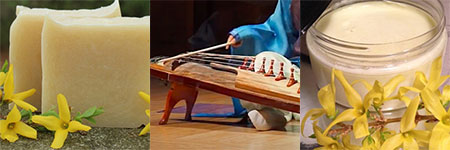
III
Forsythia Flower History
Forsythia is named in honor of William Forsyth, a Scottish horticulturist, who was a royal head gardener and a founding member of the Royal Horticultural Society. Prior to being a founder, he started as a gardener to King George II at Kensington, St. Jame’s Places, and to the Duke of Northumberland at Syon House and Curator of Chelsea Physic Garden. He was not the first to discover the yellow blossom, but it was believed that he was the first to cultivate it in Europe. Forsythia was introduced in the European gardens by mid 19th century.
Although it was named after William Forsyth, a collector named Robert Fortune made the initial discovery in 1844 while on his first botanical journey to China. Following his discovery, the Horticultural Society supported him and sent him to China to look for more spectacular and rare plants. Fortune rose to fame for bringing a variety of exotic plants to Europe.
IV
Forsythia Flower Positive Symbolism
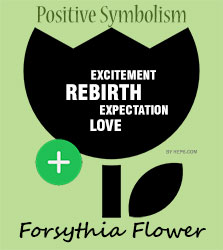
The Forsythia’s bright yellow color exudes a cheery and sunny vibe that sincerely greets the arrival of spring. It is one of the first spring blossoms to bloom, hence the primary associations which include excitement, expectation, and the rebirth of new growth every year. In Korea, these blossoms represent devotion of love.
V
Forsythia Flower Negative Symbolism
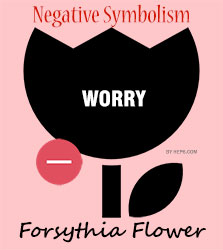
Forsythia is a flower that, like many other lovely blossoms, radiates a positive energy that can add life to any location where it is planted. It greatly carries positive connotations and symbolism as a result. However, in its relevance to anticipations and expectations, it sometimes symbolizes worry.
VI
Forsythia Flower Cultural Symbolism
It was during the Victorian era when Forsythia was first introduced to Britain. It represents anticipation and excitement for a forthcoming occasion or event. In fact, during the Victorian era, sending a flower or bouquet of Forsythias express excitement and anticipation for a celebration especially when scheduled a date or a wedding with a lover. Forsythia Flowers serve as a secret language between lovers.
It is used to express unwavering love. This is based on a Korean folktale about a guy who returns home to find his wife waiting by a Forsythia bush after a long journey. Mesmerized by her beauty, he made a promise to himself to never again take their love for granted.
Forsythias are sometimes referred to as the “Easter Tree” since they appear to blossom in full force around Easter time.
In numerology, it is related to the number four, which is thought to represent harmony and balance among the four elements of earth, water, fire, and air. It can also represent a person’s confidence and stability. They can, however, become overly at ease in their own world and, like a Forsythia, struggle to adapt to change.
Forsythia is popular at weddings and worn to remember and honor loved ones who have died away.
VII
Forsythia Flower Zodiac Sign

Forsythia is the natal flower for people who were born under the sign of Aries as they are known for being kind and a true friend. The Forsythia’s golden yellow bells represent their positive outlook on life and serve as a reminder to treat oneself kindly so that they too, can bloom and experience positive growth each year.
VIII
Forsythia Flower in Dreams
Even in dreams, Forsythia strongly symbolizes anticipation. In the waking life, Forsythias take their time to grow and bloom. This implies that when you dream of a Forsythia, you are expecting something significant to happen in your waking life. When you see this blossom that looks like a sea of gold from afar, it indicates that you are longing and anticipating peace of mind.
IX
Forsythia Flower Omens and Superstitions
There was a popular legend surrounding Forsythia Flowers that goes with the saying, “three snows after the Forsythias bloom”, which means you still have three snowfalls left before winter is completely over. So if you see Forsythias blooming, expect more snowfalls before fully welcoming the spring!
Witchcraft, however, suggests that cutting a few Forsythia stems and putting them in a jar of water on your altar can attract love. It was once thought that as Forsythia progresses into full bloom, so will your love life.
X
Forsythia Flower Mythology and Folklore
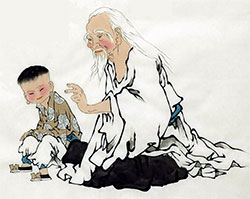
There was an ancient Chinese tale about an elderly named Qi Bo, and his granddaughter, Forsythia. Around five thousand years ago, it was believed that Qi Bo planted Forsythias in the Qibo mountain in Xinmi City, Henan Province after an incident that changed his life.
One normal day, as Qi Bo and her granddaughter Forsythia were picking up herbs on the mountain, Qi Bo tested the herbs on him to determine whether the herbs were harmful. Unfortunately, Qi Bo was poisoned. His mouth began to froth up with white foam and repeatedly called Forsythia in an attempt to get help.
Forsythia did called out for help when she realized what was going on. But nobody was in sight. Forsythia gathered a few plants around her, crushed them in her fingers, and shoved them into Qi Bo’s mouth in a desperate attempt to save her grandfather.
Miraculously, Qi Bo slowly awakened. After a few minutes, it is as if nothing happened! Qi Bo and Forsythia returned home, where he gradually recovered. Following that incident, Qi Bo started researching about the plant. After conducting extensive research and years of testing, he found that the plant can be utilized for detoxifying and eliminating heat. He identified it as an herbal medicine and named it after his granddaughter, Forsythia.

